January 12, 2011
(reposted/updated from May 1, 2009)
For a downloadable version, click the following:
Why 25+ Years of Trade Deficits?
A tale of High Real Risk-adjusted Interest Rates and the Appreciating/Depreciating Dollar
If the reader has examined the previous blogs on this issue, we should be pretty much on the same page for the discussion that follows. A short journey through the history of U.S. monetary policy for the last forty years or so will help. Recall that the 1970s saw an acceleration of inflation ultimately reaching nearly 20% at an annual rate by late 1979 and early 1980. In the spring of 1980, the FED (U.S. Federal Reserve) took a 180 degree turn and went from accommodation of inflation, much of which was due to the two oil supply side shocks of 1973 and 1978, and began a policy of “wringing out” the inflationary overhang and ignoring the consequences of a rising unemployment rate. Once the inflationary pressures began to subside, nominal interest rates fell abruptly.
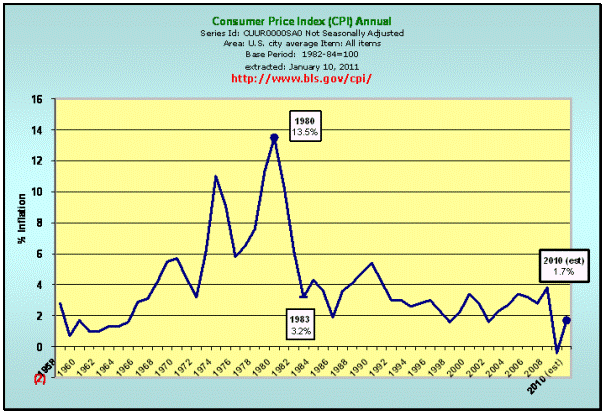
The Fisher Effect was at work again
www.econnewsletter.com/fishereffect
However, the fall in inflation was slightly greater than the fall in nominal interest rates. This caused real interest rates adjusted for risk to be relatively high compared to other nations. By around 1982, the U.S. began to experience a shift from a long standing surplus in its Trade and Current Account balances to growing deficits.
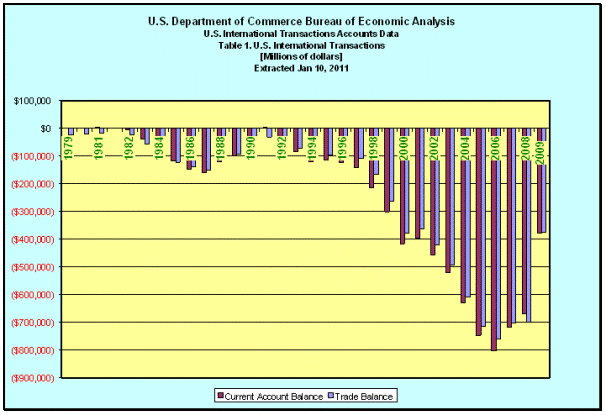
Even when the Fed funds rate was 1.00% in 2004, the capital flowed in! THEY HAVE TO INVEST THEIR DOLLARS SOMEWHERE – Foreign Investment in the U.S.
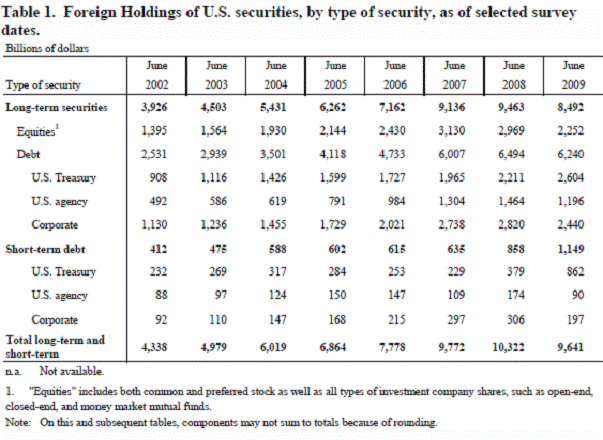
Report on Foreign Portfolio Holdings of U.S. Securities as of June 30, 2009
Department of the Treasury and Federal Reserve Bank of New York
Board of Governors of the Federal Reserve System (April 2010)
Revised: Table 2 (on May 13, 2010)
www.treasury.gov/resource-center/data-chart-center/Documents/2009.pdf
The conventional wisdom was that the U.S. slow rates of productivity growth, with accompanying increases in unit labor costs and credit card crazed consumers hell bent on instant gratification, were driving up imports and rising costs were slowing export growth.
But was this the real reason for the reversal in the Trade and Current Account balances? We think not.
There are five accounts in the conventional presentation of the BOPA (Balance of Payments Accounts). That structure does not indicate causality. Causality between the Current Account (nearly all of which is usually the Trade balance) and the Combined Capital Accounts can run either way.
This author holds and has argued for years, that because of the policy of intolerance to inflation adopted by the FED in the Spring of 1980, real risk-adjusted interest rates in the U.S. were relatively high and were a major factor that caused a surplus in the U.S. Combined Capital Account and caused the growing deficit in the Trade balance.
The U. S. was and still is the place to invest financially.
This net inflow of capital results in the demand for the Dollar (to invest in the U.S.) to rise relative to the supply of the Dollar (to invest in the rest of the World), making the Dollar scarcer and causing it to appreciate (causing the “strong Dollar”). Of course this means that foreign currencies are cheaper and the prices of foreign goods in Dollar terms are cheaper that if the Dollar had not appreciated and had remained weaker. The price of the Dollar in terms of foreign currencies rose (foreign currencies depreciated on a trade weighted basis versus the Dollar) causing the foreign currency price of American goods and services to rise and be more expensive than if the foreign currencies had not depreciated. The result was that U.S. imports of goods and services rose sharply relative to the U.S. exports of goods and services and a chronic Trade deficit as well as a chronic Current Account Deficit Balances developed.
It was the Combined Capital Account Surplus that caused the Current Account and Trade Balance Deficits and NOT the other way around.
Of course other nations enjoyed these results as their trade surpluses with the U.S. (the same thing as U.S. Trade deficits) stimulated their economies as Trade Balance surpluses do. When the Dollar weakened due to the FFTTE, the U.S. Trade deficit shrunk and European Union members shrieked loudly.
(The Financial Fiasco of Two-Thousand Eight (FFTTE))
www.econnewsletter.com/jan022009
The so-called strong Dollar and the resulting Trade Deficit was one of the reasons for the collapse of the U.S. economy in 2000 (yes 2000, and not 2001) and the weak performance of the economy during much of the Bush Administration’s period. The GDP went from a positive 7.3% real annualized growth in the 4th quarter 1999 to a negative (0.5%) real in the 3rd quarter 2000!
(1) Significant rise in federal receipts as a percent of National Income…
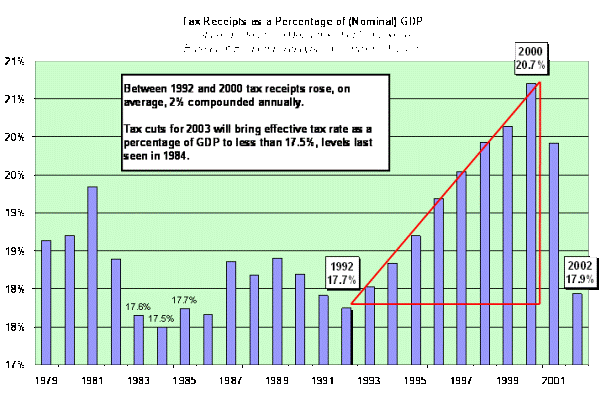
(2) …and the FED’s change to a monetary policy of restraint, leading to rising short-term interest rates.
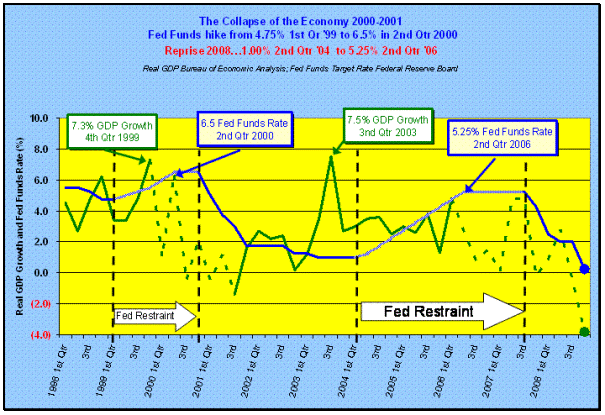

There were other factors causing the U.S. Trade deficits. For example, the Chinese depreciated their Yuan (Renminbi) (CNY) from 2 CNY/$1.00 in the early 1980s and then pegged the Dollar at 8CNY/$1.00 by the mid-1990s (currently around 6.8CNY/dollar). In Dollar terms, they flooded exchange markets with Yuan and drove the price of the Yuan from $0.50 or fifty cents to 1CNY to $0.125 for 1CNY. That is a 75% discount on the Yuan and hence Chinese goods and services. That is the reason for the huge U.S. Trade deficit with mainland China.
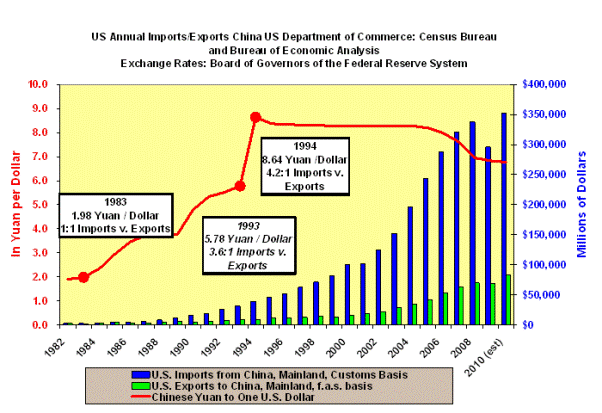

Obviously, the U.S. has gone along with this Chinese initiative, since we need a strong and stable China and no more Tiananmen Squares sapping there efforts. You can connect the dots. Be sure to re-read the first issue of this blog on the U.S. Trade Deficit topic.
I hear ideologues argue that we (U.S.) needs a strong Dollar and must avoid a Trade deficit. By a “strong” Dollar they must mean an overvalued Dollar which of course is very likely to lead to a Trade deficit. We have had a “strong Dollar” in respect to the Chinese Yuan. It was achieved by the Chinese government dumping Yuan in the foreign exchange market where Dollars are traded for Yuan. They continue to do so to maintain a peg that will give them a Trade surplus with the U.S. Arguing for a strong Dollar and a Trade surplus reminds one of unions in the labor markets.
The Law of Demand holds there as elsewhere.
- If you want a high price for labor (high compensation per hour) labor must give up job security.
- If labor wants job security, it must give up high compensation rates. Witness the U.S. auto industry and the UAW or “Big Three” portion versus the transplants.
- If you want a strong Dollar you must be willing to expect a Trade deficit.
The use of impediments to imports such as tariffs and subsidies to exports would have to be used in large doses and this is no longer acceptable to the international community. Note that in the chaos of the 1930s, nations depreciated their currencies to increase exports and decrease imports. They wanted a weak currency to achieve this Trade surplus. Seeking Trade surpluses is in effect a neo-mercantilist strategy. The nation with that Trade surplus is operating within its production possibility curve and is accepting a lower level of consumption and capital accumulation possibilities than it would have if it experienced a Trade Balance or a deficit in its Trade Balance. This was explained in the previous blogs focused on the U.S Trade Deficit.
Remember Trade Deficits are deflationary. They enable a nation to have consumption and capital accumulation possibilities not achievable with a Trade balance or a surplus in their Trade balance. But it must be financed and the resulting debt must be serviced and may be converted into domestic market dominance as the U.S. has experienced with Japan and Korea in the U.S automotive markets.
Trade surpluses usually mean a weak or undervalued currency. But trade surpluses can prove inflationary as the Chinese have recently experienced. There is no free lunch, anywhere. Somebody has to pay. Who will pay for the 2 to 3 trillion dollar stimuli packages occurring in the U.S.? Better not run a tab or you may have a cardiac arrest when you see the bill…too late.
Ciao!


